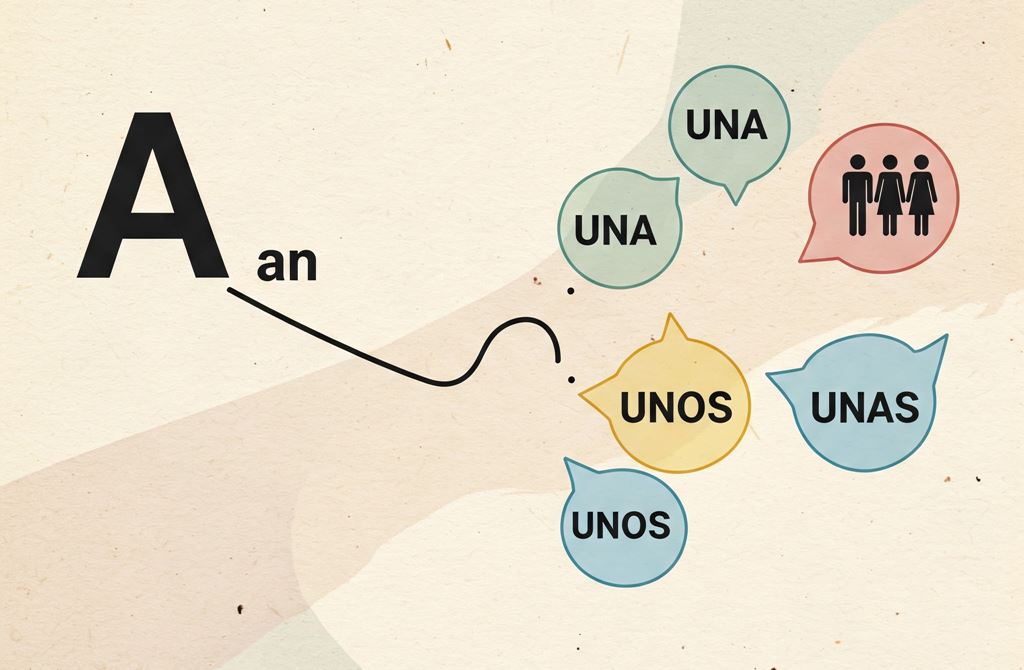Hello Spanish learners! In English, we have the indefinite articles «a» and «an». We use them to talk about a single, non-specific thing (like «a dog» or «an apple»). Simple, right? Well, in Spanish, things work a little differently because Spanish nouns have something called gender (masculine or feminine) and they can be singular (one) or plural (more than one). This means the simple «a» or «an» from English expands into a few different words in Spanish: un, una, unos, and unas.
Don’t worry! In this article, we’re going to break down exactly when and how to use each of these, with plenty of practical examples, so you can confidently talk about «a dog», «some apples», and everything in between!
So, Spanish doesn’t have a single word that is exactly like the English «a» or «an». Instead, Spanish indefinite articles change depending on two things:
The gender of the noun (is it masculine or feminine?)
The number of the noun (is it singular or plural?)
This means you’ll be using four different words where in English you might use «a», «an», or sometimes «some». These words are:
– un (masculine singular) – like «a» or «an» for masculine nouns
– una (feminine singular) – like «a» or «an» for feminine nouns
– unos (masculine plural) – like «some» or «a few» for masculine nouns
– unas (feminine plural) – like «some» or «a few» for feminine nouns
Let’s break this down with examples!
«Un» and «Una»: The Spanish Equivalents of «A» / «An»
You’ll use «un» before a singular masculine noun and «una» before a singular feminine noun. This is the most direct equivalent to your English «a» or «an».
Examples with UN (Masculine Singular):
1- Imagine you see a dog you don’t know. In English, you say «a dog». In Spanish, «dog» is perro (masculine). So you say:
– Es un perro. (It’s a dog)
2- You’re talking about a book. «Book» is libro (masculine).
– Tengo un libro interesante. (I have an interesting book)
3- You need a pen. «Pen» is bolígrafo or boli (masculine).
Necesito un bolígrafo. (I need a pen)
4- You ate a sandwich. «Sandwich» is sándwich (masculine).
– Comí un sándwich delicioso. (I ate a delicious sandwich)
Examples with UNA (Feminine Singular):
Now imagine you see a cat you don’t know. In English, «a cat». In Spanish, «cat» is gata (feminine) if it’s a female cat, or gato (masculine) generally or for a male cat.
Let’s use the feminine here: Es una gata. (It’s a cat – female)
1- You’re talking about a house. «House» is casa (feminine).
– Vi una casa bonita. (I saw a pretty house)
2- You want an apple. «Apple» is manzana (feminine).
– Quiero una manzana. (I want an apple)
3- You have an idea. «Idea» is idea (feminine).
– Tengo una idea. (I have an idea)
Key Point: Just like in English, you don’t use «un» or «una» when talking about something in general or as a concept (unless you are specifying one of them).
– Me gusta el café. (I like coffee – general concept) – No article needed before «café».
– Quiero un café. (I want a coffee – referring to one specific cup/serving)
«Unos» and «Unas»: More Than Just Plural «A»
This is where it differs more from a simple «a» or «an». «Unos» and «unas» are the plural indefinite articles. They don’t directly translate to «a» or «an» because those are singular. Instead, «unos» and «unas» often translate to:
- some
- a few
- They can also be used when you’re just talking about an unspecified number of something, where in English you might just use the plural noun without an article.
You’ll use «unos» before a plural masculine noun and «unas» before a plural feminine noun.
Examples with UNOS (Masculine Plural):
1- You see some dogs. «Dogs» is perros (masculine plural).
– Hay unos perros en el parque. (There are some dogs in the park)
2- You buy some books. «Books» is libros (masculine plural).
– Compré unos libros. (I bought some books)
3- You have a few friends (male friends, or a mixed group). «Friends» is amigos (masculine plural).
– Tengo unos amigos en Madrid. (I have some friends/a few friends in Madrid)
4- You need some minutes. «Minutes» is minutos (masculine plural).
– Necesito unos minutos. (I need a few minutes / some minutes)
Examples with UNAS (Feminine Plural):
1- You see some cats (female cats, or a group you’re referring to as feminine). «Cats» is gatas (feminine plural).
– Vi unas gatas en el jardín. (I saw some cats in the garden)
2- You buy some shirts. «Shirts» is camisas (feminine plural).
– Necesito comprar unas camisas nuevas. (I need to buy some new shirts)
3- You have a few friends (female friends). «Friends» is amigas (feminine plural).
– Ella tiene unas amigas muy simpáticas. (She has some very nice friends)
4- You eat some grapes. «Grapes» is uvas (feminine plural).
– Comimos unas uvas. (We ate some grapes)
Practice Makes Perfect!
The best way to master this is to practice identifying the gender and number of the nouns you’re using and choosing the correct indefinite article.
Look around you right now. What do you see?
- Is there a table? Mesa is feminine singular. You see: una mesa.
- Are there chairs? Sillas is feminine plural. You see: unas sillas.
- Is there a computer? Computador or ordenador are masculine singular. You see: un computador/una computadora (a computer can be femenine and masculine in Spanish)
- Are there pens? Bolígrafos or bolis are masculine plural. You see: unos bolígrafos.
Don’t be afraid to make mistakes! The key is to get used to listening for and using the correct article based on the noun. With practice, choosing between «un,» «una,» «unos,» and «unas» will become natural.



Deja una respuesta